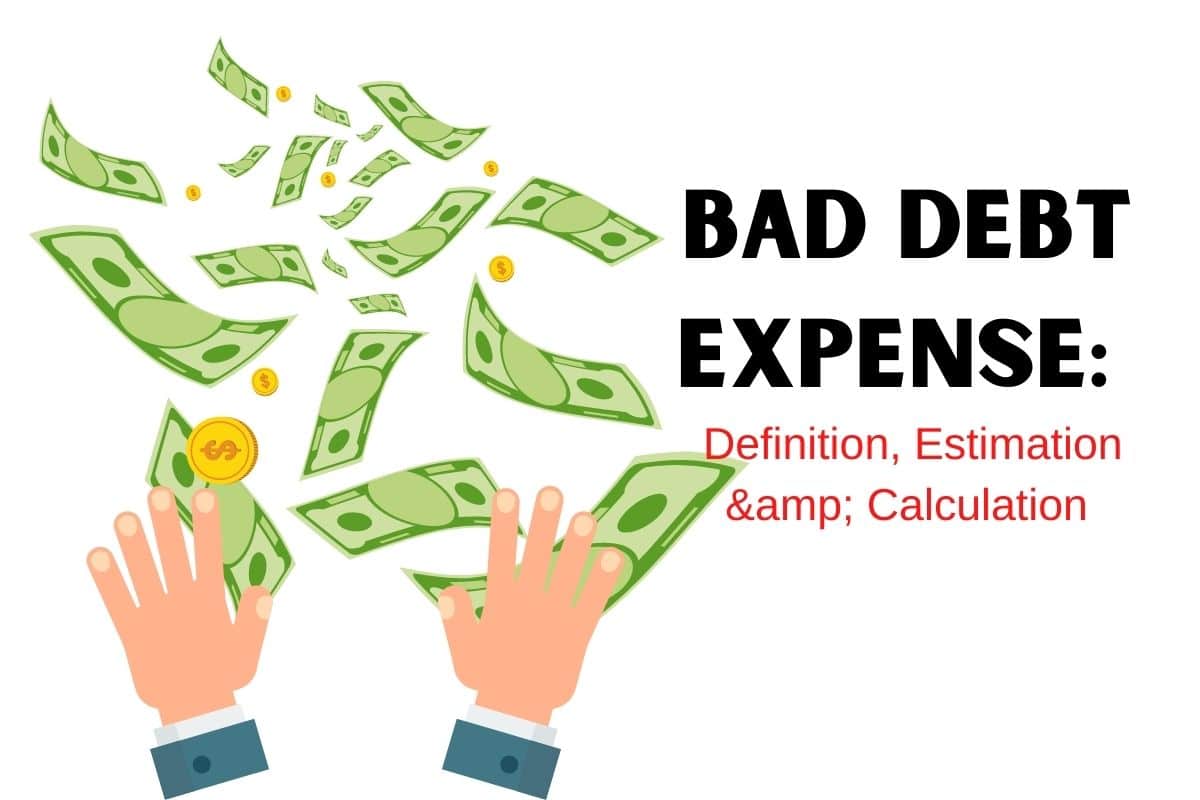You started a business on credit and you’re already overwhelmed with debt collection and you decide to withdraw it from your business account but how? By simply registering expenses- It is called Bad Debt Expense.
In this article, we will look at what the real bad debt expenses are, where they can be found in your financial statements, how to calculate your bad debts, and how to properly record bad debt expenses.
What is Bad Debt Expense?
Bad debt expenses are recorded when the claim cannot be recovered because the customer fails to fulfill their obligation to pay the outstanding claims due to bankruptcy or other financial difficulties.
Bad debt is the worst cost of doing business with customers on credit, as there is always the risk of non-payment associated with the issuance of loans.
What is Another Name for Bad Debt?
Uncollectible accounts expenditure or questionable accounts expense are other terms for bad debts expense. Bad debts are incurred when a company delivers goods or services on credit and the customer fails to pay the amount owed.
What are the Different Types of Bad Debt?
- Personal Loans
- Loan Shark Deals.
- Auto Loans
- Credit Card Debt
How to Find Bad Debt Expense?
When a company offers goods and services through debt, there is a risk that customers will not pay for them. The word debt is a bad word that refers to the obvious costs that a company thinks it will not collect and puts a lot of effort and collection into it.
Your decision to leave the customer invoice is not paid. However, if the customer avoids your call and does not attempt to negotiate a payment method and there is an invoice that is not paid within 90 days, you may consider writing the invoice as bad credit.
The reason is to provide accurate information about your financial health. Keeping these invoices helps you avoid overspending, property, and any income from these assets.
What is an Example of Bad Credit Expense?
For example, a company that is going out of business because it can no longer pay all of its bills. Some of the people it owes money to won’t get their money back, which means they have to take a loss. This is a bad debt expense on the side that won’t be able to get the money they are owed.
How to Calculate Bad Debt Expense
When calculating bad debts, choose either a direct debit method – the invoice is paid directly at the invoice price and is deducted from the account received – or the compensation method – expect bad debts even before even time to sit.
There are two ways to identify and calculate the financial loss for a company. These include:
Direct Write-off Method
This method requires payment of a payable account. When it is clear that the customer invoice remains unpaid, the invoice value is deducted directly from the expense of bad debts and deducted from the accounts received.
Bad spending accounts are taken and accounts payable are counted. In this method, there is no compensation account.
There are disadvantages to using this method. Although the direct payment method contains the amount of uncollected debt and can be used to determine a small amount, it does not comply with the GAAP rules and regulations associated with accrual accounts
Read Also: 5 proven ways to recover bad debt
The rule is to accept the expense at the time of the exchange and not at the time of payment. The direct writing method is not the most accurate way to identify bad debts.
People also search for: INCOME BOND: Definition and detailed explanations
Allowance Method
In this method, bad debts are expected even before they appear. The conditions for a suspicious account are determined by the value of the asset. This is the amount the company expects to lose each year.
This hedge account reduces the borrowing account when the two scales are listed in the balance sheet. When account holders record transactions, the negative debt associated with them is also recorded.
This is recorded as a charge of a bad debt expense account and a bad debt loan. Unpaid accounts are zero at the end of the year, counting the number of display accounts.
Methods for Estimating Bad Debt
According to GAAP rules, there are two ways in which a company can assess bad debt – the sales method, which uses the percentage of the company’s total sales over a period of time or the way the account can be repaid.
Percentage of Accounts Receivable Method
According to this approach, companies find the value of bad debt by calculating bad debt as a percentage of the available balance.
For example, at the end of the accounting period, your company has a $ 50,000 account.
Historical records show that on average 5% of all accountable accounts are not collected. Companies are also developing aging programs to assess bad debt.
You need to withdraw money from your bad account in order to have a balance of $ 2500 (5% to $ 50,000).
Percentage of Sales Method
The percentage of sales in the assessment of bad debt includes the definition of the percentage of total sales that is incomprehensible. Past customer experiences and expected monetary policy play a role in determining rates.
Once the percentage is determined, it is multiplied by the total sales of the company to determine the cost of bad debt.
For example, during one accounting period, a company reported $ 50,000 in sales. Using the trading rate method, they calculated that 5% of the trading volume could not be collected.
In this case, the company estimates that $ 2,500 ($ 50,000 x 5%) will be charged against the debt.
Where Do You Report Bad Debt Expense?
On the income statement, the cost of bad debts is listed under “selling, general, and administrative costs.” But the entries for this bad debt expense may be spread out across a set of financial statements. The allowance for bad debts is listed as a contra asset on the balance sheet. On the balance sheet, the amount of accounts receivable goes down when bad debts are written off.
How to Record Bad Debt Expense
Direct Write-Off
There are two different methods used to determine the cost of bad debts. Using the direct registration method, the non-receivable account is deducted directly from the expenses, because it becomes uncollected. This method is used in the United States for income.
However, although the direct subscription method records the number of unaccounted accounts, it does not store the appropriate rules for accrued accounts and publicly accrued profit accounts (GAAP). The relevant rules require the adjustment of expenditure to the corresponding revenue during the period of the account in which the exchange took place.
For this reason, the cost of bad debts is calculated through the subsidy method, which provides a sum of dollars to the uncollected accounts during the income period.
Allowance Method
The lending method is an account management technique that allows the company to take the expected losses in the financial statements to reduce the surplus income. To avoid overspending, the company will estimate how much of its current commercial debt is expected to disappear.
As no significant post-sale period has elapsed, the company does not know which exact account to receive and who to organize. Compensation for suspicious accounts is therefore based on expected and estimated data.
A company will pay off its bad debts and provide this relief account. Compensation for a suspicious account is an account against a property that is the opposite of a receivable, which means that the value of all debts decreases when the balance sheet is displayed in two tables. This file can be accumulated for an accounting period and can be customized according to the account balance.
Importance of Bad Debt Expense
Every financial year or quarter, the company prepares financial statements. Financial statements are managed by investors and potential investors, and they should have confidence and integrity.
Investors invest their hard-earned money in the company and sometimes, the company does not provide accurate financial statements. This means that they are misleading investors into investing in their companies based on information. wrong.
The cost of bad debt is something that must be written down. This should be calculated every time a company makes a financial statement. When a company decides to leave it, it is too self-conscious about its assets and may even forget its income.
Bad credit prices help companies determine which of their customers are more often mistaken than others. A company might decide to use a loyalty system or trust system. It can use information from bad credit accounts to determine which customers are trustworthy. Then, offer discounts on their timely payments.
Is Bad Debt a Loss or an Expense?
Technically, “bad debt” is an expense. It is included with other selling, general, and administrative costs in the report. In either case, bad debt means a drop in net income, so it is similar to both an expense and a loss account in many ways.
How Do You Write-off Bad Debt?
In general, you must have already included the amount in your income or loaned out your cash to be able to deduct a bad debt. If you use the cash method to file your taxes (as most people do), you normally cannot deduct unpaid salaries, wages, rents, fees, interests, profits, or similar items.
Conclusion
The cost of bad debt is an unfortunate expense of working with a consumer on debt. There are always countless risks to debt expansion. In order to comply with the relevant rules, bad debts must be assessed by means of compensation during the period in which the trade was executed.






1 comment